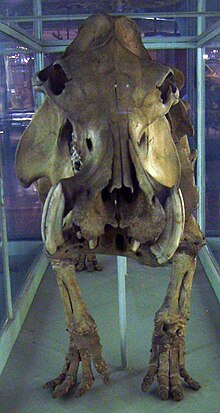User:Abyssal/Portal:Cenozoic
IntroductionThe Cenozoic (/ˌsiːnəˈzoʊ.ɪk, ˌsɛn-/ SEE-nə-ZOH-ik, SEN-ə-; lit. 'new life') is Earth's current geological era, representing the last 66 million years of Earth's history. It is characterised by the dominance of mammals, birds, and angiosperms (flowering plants). It is the latest of three geological eras, preceded by the Mesozoic and Paleozoic. The Cenozoic started with the Cretaceous–Paleogene extinction event, when many species, including the non-avian dinosaurs, became extinct in an event attributed by most experts to the impact of a large asteroid or other celestial body, the Chicxulub impactor. The Cenozoic is also known as the Age of Mammals because the terrestrial animals that dominated both hemispheres were mammals – the eutherians (placentals) in the northern hemisphere and the metatherians (marsupials, now mainly restricted to Australia and to some extent South America) in the southern hemisphere. The extinction of many groups allowed mammals and birds to greatly diversify so that large mammals and birds dominated life on Earth. The continents also moved into their current positions during this era. The climate during the early Cenozoic was warmer than today, particularly during the Paleocene–Eocene Thermal Maximum. However, the Eocene to Oligocene transition and the Quaternary glaciation dried and cooled Earth. (Full article...) Selected article on the Cenozoic world and its legaciesSeveral species of Malagasy hippopotamus (also known as Malagasy pygmy hippopotamus or Madagascan pygmy hippopotamus) lived on the island of Madagascar but are now believed to be extinct. The animals were very similar to the extant hippopotamus and pygmy hippopotamus. The fossil record suggests that at least one species of hippopotamus lived until about 1,000 years ago and other evidence suggests that the species may have survived until much more recently. The taxonomy of these animals is not resolved and not widely studied. (Full article...) Selected article on the Cenozoic in human science, culture and economicsOn the Origin of Species (or, more completely, On the Origin of Species by Means of Natural Selection, or the Preservation of Favoured Races in the Struggle for Life) is a work of scientific literature by Charles Darwin that is considered to be the foundation of evolutionary biology. It was published on 24 November 1859. Darwin's book introduced the scientific theory that populations evolve over the course of generations through a process of natural selection although Lamarckism was also included as a mechanism of lesser importance. The book presented a body of evidence that the diversity of life arose by common descent through a branching pattern of evolution. Darwin included evidence that he had collected on the Beagle expedition in the 1830s and his subsequent findings from research, correspondence, and experimentation. The opening sentences demonstrate that Darwin did not see the role of natural selection in species conformity or what is now called stabilizing selection. This was not corrected in editions subsequent to Darwin reading the correct explanation In Patrick Matthew's book in 1860 which had been published in 1831. Various evolutionary ideas had already been proposed to explain new findings in biology. There was growing support for such ideas among dissident anatomists and the general public, but during the first half of the 19th century the English scientific establishment was closely tied to the Church of England, while science was part of natural theology. Ideas about the transmutation of species were controversial as they conflicted with the beliefs that species were unchanging parts of a designed hierarchy and that humans were unique, unrelated to other animals. The political and theological implications were intensely debated, but transmutation was not accepted by the scientific mainstream. The book was written for non-specialist readers and attracted widespread interest upon its publication. Darwin was already highly regarded as a scientist, so his findings were taken seriously and the evidence he presented generated scientific, philosophical, and religious discussion. The debate over the book contributed to the campaign by T. H. Huxley and his fellow members of the X Club to secularise science by promoting scientific naturalism. Within two decades, there was widespread scientific agreement that evolution, with a branching pattern of common descent, had occurred, but scientists were slow to give natural selection the significance that Darwin thought appropriate. During "the eclipse of Darwinism" from the 1880s to the 1930s, various other mechanisms of evolution were given more credit. With the development of the modern evolutionary synthesis in the 1930s and 1940s, Darwin's concept of evolutionary adaptation through natural selection became central to modern evolutionary theory, and it has now become the unifying concept of the life sciences. (Full article...) Selected imagesNeed help?Do you have a question about Abyssal/Portal:Cenozoic that you can't find the answer to? Consider asking it at the Wikipedia reference desk. TopicsGeochronology - Paleogene (Paleocene - Eocene - Oligocene) - Neogene (Miocene - Pliocene) - Quaternary (Pleistocene - Holocene) Cenozoic landmasses - Major Cenozoic events - Paleogene biota appearances - Neogene biota appearances - Quaternary biota appearances - Fossil sites - Stratigraphic units - History - History of paleontology - Timeline of paleontology Researchers - Culture - Treatise on Invertebrate Paleontology - Vertebrate Paleontology Quality ContentFeatured Cenozoic articles - Good Cenozoic articles - History of paleontology - Evolutionary history of life SubcategoriesRelated contentAssociated WikimediaThe following Wikimedia Foundation sister projects provide more on this subject:
|


































